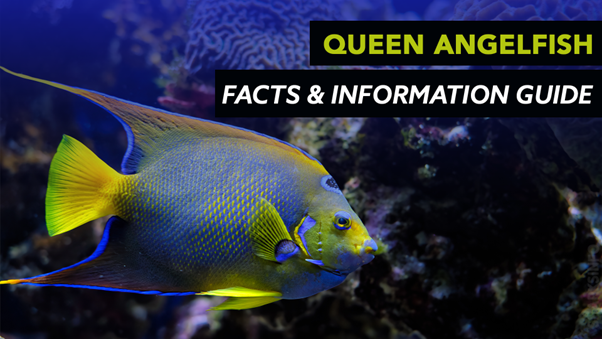Considered one of the most beautiful fish in the ocean, the queen angelfish, known as yellow angelfish or golden angelfish, is definitely worth a sight. Its compressed but blue and yellow colored body works as eye candy for humans, that’s why they are kept as aquarium pets in abundance. Queen angelfish are of solitary nature, usually found swimming alone. Let’s explore more about this adorable marine specie.
Queen Angelfish Facts & Information Guide
Scientific name: Holocanthus ciliaris
Taxonomic Classification

Physical Attributes
Queen angelfish has quite a distinct appearance which is pleasant to the eyes. They have dark blue and yellow coloration on their bodies, having blue dorsal fin, blue anal fin, and a black spot on the head. In some species, the fins could be yellow as well. The tail is yellow in color and their bodies might have purple or orange highlights on them.

Queen angelfish have flat, compressed bodies with a rounded heads. Their distinctive feature is the presence of a blue or black spot on top of their heads, which are considered their crowns, thus the name Queen Angelfish. They have wet and slimy scales on their bodies and have small mouths which contain brush-like slender teeth.
Habitat And Geographical Distribution
Queen angelfish prefer coral and rocky reefs for their living habitat. Queen angelfish are found in abundance in the Caribbean waters. They are limited to the waters of the tropical western Atlantic right from Bermuda to Brazil as well as from the Windward Islands to Panama.

Size And Weight
The adult queen angelfish can grow upto 18 inches and weigh around 1.6 kg
Reproduction
Just like Blue Tang, the Queen Angelfish also reproduces via the “Broadcast spawning” method. They prefer monogamy as the pair can be seen together for a long time. Both males and females rise up in the water from reefs, bring their bellies to close, and release a spawn of eggs and sperms.
The released eggs are transparent and buoyant which allows them to float in the water column, saving them from the attacks of the predators. After fertilization, the egg hatches in 15-20 hours into larvae and within the next 48 hours, the larvae develop by absorbing the yolk sac. These larvae feed on plankton until they become adults.
The average lifespan of queen angelfish in the wild is upto 15 years.
Diet Of Queen Angelfish
Queen angelfish are omnivores who like to feed on a variety of invertebrates. In their habitats, they mainly feed on sponges as well as algae, jellyfish, tunicates, sea fans, plankton, hydroids, anemones, soft corals, and bryozoans.
Queen angelfish are kept as aquarium pets as well and in captivity, their diet varies. In captivity, they feed on dried algae sheets, flake food, Mysis and brine shrimp, spirulina, and chopped fish and vegetables.

Conservation Status
According to IUCN, the population of Queen Angelfish is stable, thus its conservational status is Least Concern.

Conservation status of Queen Angelfish
Do Queen Angelfish Pose Threat To Humans?
Queen angelfish do not bite or attack humans, thus it is not a threat to them. However, its consumption by humans can cause Ciguatera poisoning which affects the muscular, digestive, and neurological systems of humans. That is why it is advisable to avoid eating raw queen angelfish.
Fun Facts About Queen Angelfish
- Queen angelfish is a reef fish
- The black spot on its forehead resembles a crown
- Queen angelfish consume a variety of soft-bodies animals
- They can live as maximum as 15 years
The Final Word
Queen angelfish lives in coral reefs and is found in the depths of the western Atlantic Ocean, feeding on algae, sponges, plankton, and anemones. Due to their vibrant appearance, they are loved by humans and are kept in aquariums as a pet. However, their population count is stable even after mass captivation, thus their conservation status is of least concern.







